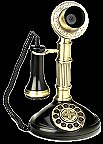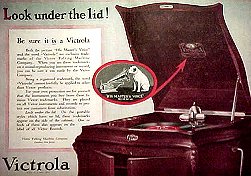 Consumer Products of the 1920's were a big step in the direction of making new things and developing great new things. In the 1920's many things were made very popular such as the Phonograph.The phonograph was first invented in 1877. In 1920 there 7 million phonographs in the United States. The most well known phonograph was called the "Victor Victrola". To the people the phonographs were an important thing to have in the house, but still they were very exspensive. Alot of people reffered to them as: talking machines, music
machines, and phonographs.
Consumer Products of the 1920's were a big step in the direction of making new things and developing great new things. In the 1920's many things were made very popular such as the Phonograph.The phonograph was first invented in 1877. In 1920 there 7 million phonographs in the United States. The most well known phonograph was called the "Victor Victrola". To the people the phonographs were an important thing to have in the house, but still they were very exspensive. Alot of people reffered to them as: talking machines, music
machines, and phonographs.

Another important product that many people felt they had to have was the "Radio". Even though if you wanted a radio you had to put it together yourself, but many people thought it was a neccesary thing to have.These sets used a wire wrapped around a Quaker Oats box, and were tuned by touching a "cat's whisker" to a mineral crystal. Headphones were used for listening. In 1922, Westinghouse, a large radio producing company, put the first pre-assembled radios on the market. Ever since then the radio has become an important communication item as well for entertainment.

Other Products that many people started to use are as follows:
 |
 |
| Meals & Snacks: |
Beverages: |
| Planter's Peanuts |
Hires Root Beer |
| Wheaties (1924) |
Kool-Aid drink mix |
| Kraft cheese |
7-UP (1929) |
| Gold Medal Flour |
Orange Crush |
| Kellogg's Corn Flakes |
Coca-Cola |
| Oscar Mayer wieners (1929) |
Dr. Pepper |
| Birds-Eye frozen vegetables (1928) |
Pepsi-Cola |
| Del Monte canned foods |
Welch's grape juice |
| Kellogg's Rice Krispies (1928)
| Fruit Smack drink mix |
| Peter Pan peanut butter (1928) |
| Libby's canned tomato soup |
| Green Giant canned peas (1925) |
| Jell-O ice cream powder |
| Cracker Jack |
| Cream Of Wheat |
| Other Products: |
| Fountain Pens |
Hallmark Greeting Cards |
| Cigarette Lighters |
| Dixie Cups |
| Sani-Paper Towels |

One of the big steps forward in technology was the telephone. The new telephone had a handle which the mouthpiece and speaker were placed together in a hand-held receiver.All out-of-town calls required operator assistance. You gave her/ him the city and state, the exchange or central office name, and the subscriber number. You waited on the line while the connection was made, unless it was going to take a long time. If it took forever the operator would call you back and forward your call. That is how the telephone was popular and how it was used during that time.

|